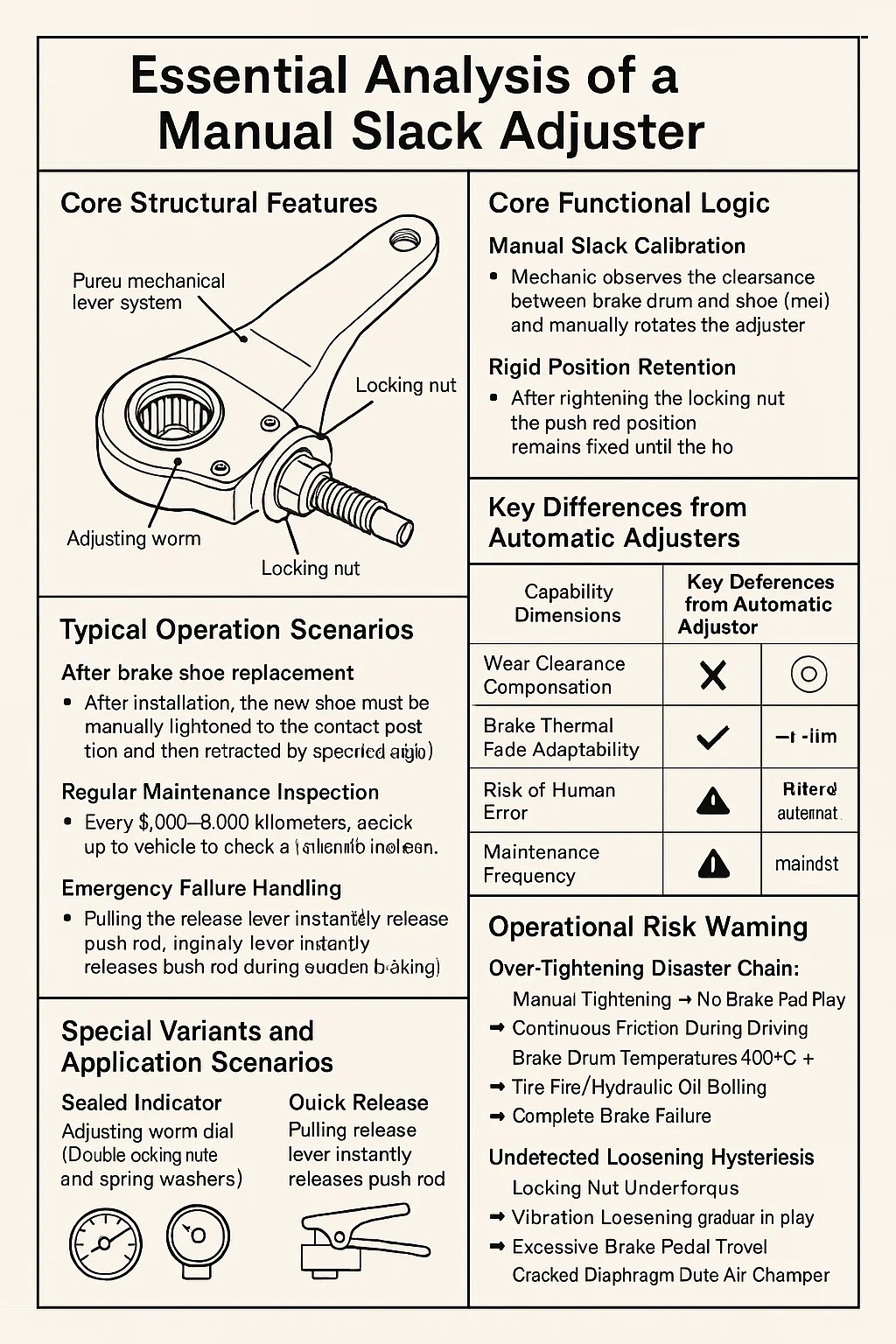 (+86)-137 5851 1881
(+86)-137 5851 1881

Essential Analysis of a Manual Slack Adjuster
1. Core Structural Features
Purely mechanical lever system: Manual rotational force is amplified and transmitted to the push rod through an exposed adjusting worm, worm gear, or hexagonal head.
No automatic compensation mechanism: No internal adaptive components such as ratchets or counters; operation relies on visual observation and tools.
2. Core Functional Logic
Manual Slack Calibration: The mechanic observes the clearance between the brake drum and the shoe (measured with a feeler gauge) and manually rotates the adjuster to the preset theoretical value.
Rigid Position Retention: After tightening the locking nut, the push rod position remains fixed until the next manual intervention.
3. Typical Operation Scenarios
After brake shoe replacement: After installation, the new shoe must be manually tightened to the contact position and then retracted by the specified angle (e.g., three worm teeth).
Regular Maintenance Inspection: Every 5,000-8,000 kilometers, the vehicle must be jacked up to check the clearance and readjusted if it is out of tolerance. Emergency Failure Handling: In the event of an automatic adjuster failure, temporarily manually adjust the clearance to maintain vehicle movement to a repair point.
4. Key Differences from Automatic Adjusters
| Capability Dimension | Manual Slack Adjuster | Automatic Slack Adjuster |
|---|---|---|
| Wear Compensation | Entirely manual intervention required | Real-time autonomous adjustment |
| Thermal Fade Susceptibility | Fixed clearance → Heat expansion cancels braking force | Dynamically maintains optimal clearance |
| Human Error Vulnerability | Over-tightening → Brake drag → Fire hazard | Mechanical anti-tamper logic |
| Maintenance Frequency | Requires frequent manual checks/adjustments | Maintenance-free for design lifespan |
| Failure Mode | Nut loosening → Runaway clearance → System failure | Internal seizure/fracture → Compensation paralysis |
5. Special Variants and Application Scenarios
Scaled Indicator: The adjusting worm is equipped with a dial that quantifies the retraction angle (specially designed for marine anchor brakes).
Vibration-Resistant Heavy-Duty Type: Double locking nuts and spring washers prevent loosening caused by vibration from mining machinery (old-style brakes for mining trucks). Quick Release: Pulling the release lever instantly releases the push rod, making brake pad replacement easier (on some agricultural machinery).
6. Operational Risk Warning
Over-Tightening Disaster Chain:
Manual Tightening → No Brake Pad Play → Continuous Friction During Driving → Brake Drum Temperatures of 400°C+ →
Tire Fire/Hydraulic Oil Boiling → Complete Brake Failure
Undetected Loosening Hysteresis: Locking Nut Undertorque → Vibration Loosening → Gradual Increase in Play → Excessive Brake Pedal Travel → Cracked Diaphragm Due to Air Chamber Push Rod During Sudden Braking
